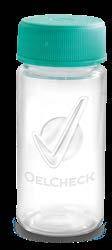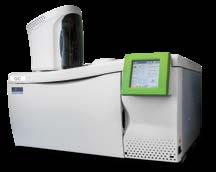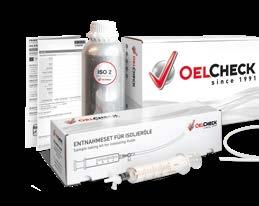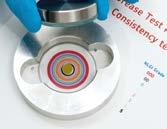Coolants in stationary gas engines –Tectrol takes full advantage of analytics
Tectrol has developed the Coolprotect range of coolants tailored to the requirements of the engines and the properties of Tectrol MethaFlexx gas engine oils. Ready-mix products were created in particular to permit simple and safe use.
The cooling system as a source of danger
Regular
gas engine oil,


the
The Tectrol brand stands for high-quality lubricants for almost all applications. Its core competencies include lubrication and cooling of stationary gas engines that generate energy in CHP plants. As a technological pioneer, Tectrol recognised at an early stage that high-performance gas engine oils can achieve successful results only in combination with oil analyses. Now it is also leading the way when it comes to monitoring the coolants of these gas engines. After all, it has become clear over the years that the cause of around 15% of all defects in
the
is not sufficient.
after a maximum of 2,000 operating hours. gas engines can be found in their cooling systems. Tectrol and OELCHECK have therefore also maintained a long-standing cooperation in the field of coolant analysis.

Tectrol MethaFlex gas engine oils offer the best protection for combined heat and power plant (CHP) gas engines even in long-term use. Over 4,000 CHP engines powered by natural, bio or special gases use one of the more than ten Tectrol gas engine oil types. Together, the engines achieve over 30 million operating hours per year!
Around 15 % of all faults in CHP systems have their starting point in the cooling system. However, the importance of the coolants was often underestimated or the handling of the fluids was not carried out correctly. Modern coolants are high-tech products on which the reliable performance of the cooling system and engine depends. Above all, they must continuously dissipate the heat from the engine, because this must be operated with only slight temperature fluctuations. A constant flow rate that is not affected by deposits or air inclusions is essential for this. The active ingredients added to the agents must reliably prevent corrosion, erosion, cavitation, foaming and any kind of deposits.
Good compatibility with all installed components is a matter of course. The additives must protect the various metal alloys, elastomers and plastics installed in engines, cooling hoses, seals and in the expansion tank over the entire service life of the engine. If heat is not dissipated from thermally
Check-up
Abusiness trip! How nice would it be to go on a trip to a training event, seminar or symposium at the present time! Find out new things, exchange ideas, meet like-minded people and make interesting contacts again – we all need these stimuli and the contact with each other. However, further training and communication do not necessarily have to be paused when travel options are limited, and with your workplace even moved to within your own four walls.
Breathe new life into your workplace! Take a digital trip to the world of lubrication and lubricant analysis! For example, our partners from the OilDoc Academy offer a whole range of exciting topics. You only need one hour for an online seminar. You can take part from anywhere. Instead of dry technical lectures, practically-oriented events full of information and examples await you. Many online training sessions are also available for you as recordings at any time.
The seminars and certification courses lasting several days to convey more complex topics will continue to take place at the OilDoc Academy in 2021. Safety is ensured by a comprehensive protection and hygiene concept. Anyone who cannot be there in person still does not have to do without: at all face-to-face events, the camera is also on and you can take an interactive part in the seminar from your workplace.
But no matter whether online excursion or a personal seminar visit – companies also benefit from the training events as well as the participants. After all, these depend more than ever on smoothly functioning systems and machines, as well as the commitment, knowledge and innovative ideas of their employees.
Sincerely, Barbara Weismann
loaded engine components, the gas engine oil is subjected to even higher demands. In most cases, its temperature load increases and the oil ages more quickly. Its viscosity and thus its lubrication performance decrease. Overall, the service life of the oil is shortened and the oil must be replaced sooner.
Safe and fast with ready-mix
Coolant concentrates are mixed with water before use. But tap water is often not suitable for this.
Engine manufacturers specify accurate values for total hardness, electrical conductivity and the calcium or chloride content of the make-up water. Failure to comply with these specifications can lead to malfunctions in the cooling circuit. However, preparation of make-up water that meets specifications often poses major challenges for users.
Tectrol has the perfect solution for this: ready-mix coolant from the Tectrol Coolprotect-Mix series! The products are pre-mixed with specified make-up water and can be used immediately. Tectrol Coolprotect Mix is approved by leading engine manufacturers and offers the certainty that the mixture is correct. The excellent product properties enable extended coolant change intervals and protect against deposits, cavitation, foam and corrosion. The volume flow is not restricted, the engine is optimally cooled and the cooling system remains clean.
As in the assessment of oil analyses, the interrelationships of the values determined for coolants are considered. The focus is on the remaining performance potential of the coolant and any indications of damage in the cooling system. However the limit values for the respective assessment criteria are a particular challenge for diagnosis. Many engine manufacturers have so far published no or very few limit values for used coolants. For this reason, OELCHECK and Tectrol have defined limit values based on their own experience and the existing broad database.
Thanks to continuous trend monitoring, Tectrol was able to detect a number of system faults early on and recommend remedial measures to the user. However, the specified change intervals of coolants remain a critical topic. It is risky to simply replace them at regular intervals of one to three years without further consideration. Since operating conditions and coolants can change very quickly in some cases during use, well-known gas engine manufacturers already require short-term changes after 2,000 operating hours (max. 6 months) due to prematurely reached limit values.
Coolant analytics – Typical limit values
As with the evaluation of lubricant analyses, OELCHECK tribologists also always consider the interrelationships of the values defined for coolants. They also take into account individual conditions of use and the results of previous trend analyses.

The limit values or tolerance ranges published here are for general guidance only. They are based on the specifications of well-known engine manufacturers and on the data of all coolant samples that OELCHECK has examined since 2017.
in Typical range Warning value Explanations
Colour Deviates in colour from that of the fresh product: Indication of mixing, ageing or contamination.
Refractive index 20 °C 1.33 - 1.4 For glycol concentration determination. Influences above all the thermal properties of the coolant.
Glycol concentration % [Vol/Vol] 0*;35 - 60 <30; >65 Too low ð reduced frost and corrosion protection ð higher risk of cavitation. Too high ð insufficient cooling effect.
A pioneer in coolant analytics

Tectrol began to very intensive work on coolant analysis as early as 2013. The challenges were not necessarily to determine individual values, but rather to define an analysis scope that was manageable for all users while at the same time allowing meaningful diagnosis. It also seemed difficult to find a laboratory for this type of water analysis at first. The solution was obvious: OELCHECK was already the proven partner for oil analyses and was already focused on coolant analysis back then. After intensive exchange with leading engine and coolant manufacturers, OELCHECK presented the groundbreaking analysis kits for coolants at the beginning of 2017.
Tectrol generally advises coolant analyses after a maximum of 2,000 operating hours. Replacement is usually not recommended until the analysis values exceed or fall below limit values. With a preceding flushing process and the subsequent use of the ready-mix product from the Tectrol Coolprotect Mix series, this process can be completed without long interruptions in operation.
Water quality
Condition
Density 20 °C kg/m³ 1000*; 1030 - 1080 <1030;>1080 Used in conjunction with the refractive index, among other things, to characterise a coolant.
pH value 25 °C 7.2 - 10* <7.0; -10% Measure of acidic/base character. Important for assessing the tendency to corrosion. Falling pH value indicates the end of the coolant’s performance capacity.
Conductivity 25 °C μS/cm > 3000 3000 Change indicates ageing, mixing or additive degradation.
Freezing point °C 0*; -45 - -30 >-25 Temperature at which a coolant (mixture) freezes. *) In special cases, pure corrosion inhibitors are used.
Water hardness °dH 0 - 10 15 Water hardness too high ð limescale deposits ð reduced heat transfer ð overheating problems.
Alkaline earths mmol/l 0 - 2 2.7 Alkaline earth metal salts soluble in water. Together they determine the hardness of the water.
Calcium mg/l 0 - 100 150 Hardener
Magnesium mg/l 0 - 100 150 Hardener
Sulphate mg/l 0 - 20 50 Contamination (e.g. from the preparation water). Promotes corrosion.
Tectrol - a joint BayWa and Agravis brand Tectrol is a joint trademark of BayWa AG and Agravis Raiffeisen AG. It stands for high-quality lubricants for trade, industry and agriculture.
Tectrol: Analyses
every 2,000 operating hours
OELCHECK universal kits for gas engines enable analysis of engine oils and coolants. Tectrol uses the universal kits in a targeted way. Customers order the kits conveniently from Tectrol and send the samples to OELCHECK for analysis. The laboratory reports are first sent with an initial diagnosis to the responsible employees in the Tectrol application engineering department. As they are familiar with the plants and the local operating conditions, their many years of experience are included in a concluding comment. This means that customers receive particularly individual and accurate diagnoses.
BayWa is a globally active group with the core segments of agriculture, energy and construction as well as the development segment Innovation and Digitalisation. The Renewable Energies business unit has developed into an important mainstay since 2009. With 19,000 employees in more than 40 countries, the company generated sales of over 17 billion euros in 2019.
AGRAVIS Raiffeisen AG is a modern agricultural trade company in the agricultural products, animal nutrition, crop cultivation and agricultural technology segments. It also operates in the areas of energy and Raiffeisen markets, including the building material trade and project construction. With around 6,500 employees, the AGRAVIS Group generates 6.5 billion euros in sales revenue.
Further information: www.baywa.de / www.tectrol.de / www.agravis.de
Corrosive wear
Sodium mg/l 0*; 100 - 10000 ± 25% Corrosion protection
Phosphorus mg/l 0*; 15 - 3000 ± 25% Fe corrosion protection
Boron mg/l 0*; 25 - 4000 ± 25% Fe corrosion protection
Potassium mg/l 0 - 10000 ± 25% Fe corrosion protection Silicon mg/l 0; 25 - 250 ± 25% Al corrosion protection
Molybdenum mg/l 0*; 15 - 1000 ± 25% Fe corrosion protection
Nitrate mg/l 0*; 25 - 2500 ± 25% Fe corrosion protection
Nitrite mg/l 0; 700 - 4000 ± 25% Fe corrosion protection
Chloride mg/l 0 - 50 150 Hardener. Concentration too high corrosion. Very high temperatures accelerate this. Additives
Phosphate mg/l 0; 5- 10 ± 25% Fe corrosion protection, pH stability
Adipic acid mg/l 0*; 15 - 10000 ± 25% Fe/Al corrosion protection
Acetate mg/l 0*; 15 - 5000 ± 25% Fe/Al corrosion protection
Benzoic acid mg/l 0*; 1000 - 20000 ± 25% Fe corrosion protection
Sebacic acid mg/l 0*; 1000 - 20000 ± 25% Fe corrosion protection
Benzotriazole mg/l 0*; 100 - 6000 ± 25% Non-ferrous metal protection
Tolyltriazole mg/l 0*, 500 - 6000 ± 25% Non-ferrous metal protection
Iron mg/l 0 - 2 7 Pipes, roller bearings, pump housings, sealing rings
Chromium mg/l 0 - 1 1 Roller bearings and other chromium-containing or chrome-plated components
Aluminium mg/l 0 - 2 5 Housings and other light metal components, including bronze components
Nickel mg/l 0 - 1 1 Nickel or nickel-plated components
Copper mg/l 0 - 2 5 Main component of brass and bronze, e.g. pipes, heat exchangers
Lead mg/l 0 - 2 5 From soldered joints
Zinc mg/l 0 - 2 5 Brass components or galvanised components, e.g. screw couplings
Tin mg/l 0 - 2 5 Constituent of tin bronze, tin solder
Glycolate mg/l <300 1000 Glycol degradation products caused by high temperatures.
Formate mg/l
Fluoride
mg/l
mg/l
<100
100 Glycol degradation products caused by high temperatures.
Gas chromatographs –The finest detection noses in the OELCHECK laboratory

Is a used engine oil contaminated with fuel? Has an engine oil been too heavily contaminated with biodiesel or vegetable oil? Has the wrong fuel been refuelled? Is there coolant in the oil sample? Does the DGA (dissolved gas analysis) of a transformer oil show a gas composition that indicates a likely fault in the transformer in the near future?
OELCHECK tribologists are confronted with such questions on a daily basis. Gas chromatography (GC) provides exact information to answer these questions as it can be used to analyse substance mixtures both quantitatively and qualitatively. The prerequisite for an analysis is that the mostly liquid samples become gaseous without decomposition when heated or are already gaseous.
Four gas chromatographs are installed in the OELCHECK laboratory for analysis of up to 2,000 samples that are tested daily. Although set up for different purposes, they work according to a uniform principle. The sample to be examined is fed to the gas chromatograph via an injector. It then vaporises the sample. The now gaseous components are injected into a capillary column mounted in a thermally controllable oven. Gases pass through a long, thin glass tube with an inner diameter of less than 1 mm but with a length of up to 30 m. This is coated internally with a thin film, the stationary phase. A carrier gas such as hydrogen or argon, the mobile phase, continuously flows through this separation column. The gaseous components of the sample supplied from the injector remain at the stationary phase of the column for different lengths of time depending on their structure and the temperature in the oven chamber. As the individual components leave the column, a detector identifies them. They are recorded in a chromatogram and can be assigned to specific initial materials according to their boiling temperature. The later a component is detected at the column outlet, the higher its boiling point. The area under a peak in the chromatogram is proportional to the amount of the component in the mixture.
Fuel in engine oil –
Too much is unhealthy
In the OELCHECK laboratory, the fuel content of all used engine oils from diesel, petrol and biodiesel engines, with the exception of oils from gas engines, is tested with the gas chromatograph. As the components of fuels generally have a lower boiling point than those of engine oils, they can be separated from each other and quantified using gas chromatography. The laboratory report specifies the percentages of the respective fuels in % (m/m).
Unburned fuel can always get into the engine oil during fuel combustion in the engine. However, if it contains too much fuel, its viscosity decreases and a wear-protecting lubricating film can no longer build up reliably. Increased fuel input can be due to a wide variety of causes:
Frequent cold starts with formation of condensation
Extreme stop-and-go operation
Condensation of blow-by gases due to incorrectly set carburettor or poor timing
Incomplete combustion due to insufficient compression as a result of worn cylinders or piston rings

Incorrect fuel/air mixture due to blocked air filter, damaged inlet or outlet valves
Incorrectly set ignition time, defective injection nozzles, burnt spark plugs
When using biodiesel (RME, FAME), it must be noted that this type of fuel has a higher boiling temperature than fossil diesel and vaporises less well at operating temperature.
OELCHECK tribologists have defined limit and warning values for the permissible fuel content for different engine and fuel types.
Ethylene glycol in engine/ transmission oils –
The indicator for coolant contamination
The headspace gas chromatograph in the OELCHECK laboratory is used for this analysis. This detects even very low levels of ethylene glycol, the clear indicator of coolant contamination, with high precision.
The analysis must be commissioned as an individual test. In the laboratory report, the GC glycol content in mg/kg is indicated under the heading “Contamination”.
Headspace gas chromatography is a special variant of the GC procedure to separate volatile components of a substance mixture from non-volatile or hardly volatile constituents. First, a reagent is added to the oil sample which derivatises the ethylene glycol contained in the sample. The oil sample is then heated to 120 °C in a tightly sealed glass bottle. The volatile components – including the derivatised ethylene glycol – evaporate. This vapour is collected and a sample separated from it. All the components contained in the vapour are then separated according to their boiling points in the gas chromatograph. The ethylene glycol is detected precisely. This method provides even more accurate data than the FT infrared spectroscopy routinely performed for all analysis kits.
Particularly in the case of increased water content, detection of glycol in the engine or transmission oil provides a clear indication that coolant has entered into the oil circuit. If glycol is detected in the oil, it is very important to check how the coolant entered the lubricating oil. The most common cause in internal combustion engines is a defective seal. With a transmission oil cooler, the pipes, which usually contain copper, can be corroded in such a way that leaks have formed.
Rule of thumb: The engine oil of a petrol engine should never contain more than 1-2 % fuel. For diesel engines, the limit value is 5-7 %. In operation with pure biodiesel (B100), a share of more than 6 % is usually considered critical.
“Simulated distillation” –Fuels in the spotlight
Commercially available fuels vaporise at different temperatures. The vaporisation process is simulated as distillation with the gas chromatograph. The distillation process is recorded in a boiling profile. The data obtained is compared with the standardised characteristic values of the individual fuel types.
This shows whether fossil diesel or biodiesel meet the requirements of the standard. Incorrect refuelling or impurities, such as petrol with diesel, diesel with biodiesel, can also be clearly detected. Even a mixture of conventional fuels with vegetable oil is visible. However, such contamination is usually detected by other test methods, such as FT-IR spectroscopy or viscosity change.
For diesel fuel, the cetane index, a measure of ignitability in accordance with EN 590, can also be
determined with the help of the “simulated distillation” and the density. The cetane index provides information on the speed of self-ignition of the diesel fuel after injection. The higher the cetane index, the better the diesel grade because the time between injection and combustion decreases and the ignitability increases.
Fossil diesel fuel, which must contain 7 % biodiesel according to the standard, must have a cetane index of at least 46. Diesel fuels with a higher biodiesel content of 10, 30 or even 100 % have a lower cetane index. If a borderline value or even lower value is determined in the analysis performed in the OELCHECK laboratory, this indicates a diesel whose biodiesel content is higher than in EN 590 and whose use can cause a reduction in engine performance or ignition problems.
The evaporation loss –Specialist for special cases
Measurement of evaporation loss is an extension of the “simulated distillation”. OELCHECK performs determination of the evaporation loss with the gas chromatograph as an individual analysis that must be commissioned separately. It is used, among other things, for the assessment of mostly synthetic base oils selected for the formulation of new engine or compressor oils. Completely formulated high-temperature lubricants, such as those used for lubrication of chains in furnace systems, glass and chipboard production as well as in film stretching lines, can thus be assessed before practical use.
During the analysis, an oil sample is heated in the injector of a gas chromatograph and its components are differentiated in a separating column depending on their rising boiling temperature. The diagram of the boiling process is divided into equidistant intervals of 1 % of the total area. In each of these intervals, the measured mass fraction of the sample is multiplied by a specific evaporation loss factor. The higher the boiling temperature, the smaller this factor. It is necessary to include the loss factor in calculation as this measurement is not a real distillation, but a simulated one. The calculation determines a partial evaporation loss for each interval. These partial evaporation losses then result in the total evaporation loss.
As a result, the evaporation loss of a sample at a temperature of 250 °C can be determined. The most important prere quisite for the measurement using this procedure is that the sample must be fully vaporisable.
Gas-in-oil analysis –Safety for transformers
Insulating oils are intended to prevent voltage flashovers in transformers and extinguish any arcs during switching. They insulate and cool live parts, are characterised by low-temperature and oxidation stability, and harmonise with winding and insulating materials. The oils often remain in use for decades and must be monitored by means of trend analyses. OELCHECK offers five analysis kits especially for transformer oils which permit determination of the gases dissolved in the oil. Besides water determination, this gas-in-oil analysis is the most important analysis for monitoring transformers, as it makes a decisive contribution to operational safety. A special headspace gas chromatograph is used for the analysis. The laboratory report lists values for the respective gases determined in ppm and their total. Gas-in-oil analysis uses the insulating oil’s ability to dissolve air from the atmosphere as well as cracked gases. These are produced not only due to the natural ageing of oil and insulation materials, but above all when thermal or electrical defects occur in transformers. The extent of a defect and remedial measures can be concluded from the quantity of dissolved gases in the respective oil and their increase over time (trend analysis).
To obtain correct measurement results, the oil sample must not come into contact with the ambient air. OELCHECK therefore equips every all-inclusive analysis kit for transformer oils not only with a hermetically sealable sample bottle, but also with a gas-tight 20 ml glass syringe. Only this must be used to take a sample.
In the laboratory, the type and intensity of the gases contained in the oil are determined with a gas chromatograph. Depending on the intensity of the individual gases, it is then possible to differentiate between different fault types. Conclusions regarding the consequences for the transformer oil or paper insulation can be drawn from the corresponding fault types. These values and their diagnosis are noted in the laboratory report in compliance with evaluation procedures defined in the VDE standard.

Antioxidants –Elixirs of life for modern lubricants
OELCHECK checks oxidation with the RULER test and IR spectroscopy


For OELCHECK custo mers, the basic proce dure remains unchanged. However, the parameters are determined even more precisely by different methods, providing greater confidence in the interpreta tion of laboratory results.

The ageing process to which all lubricants are subjected during their use is essentially dominated by the oxidation of the base oil. The speed of this oxidation process is mainly influenced by temperature.
For mineral oils without additives, the rule of thumb (Arrhenius rule) applies that oxidation doubles from an operating temperature of approx. 60 °C when the temperature increases by 10 °C in each case. In modern lubricants, “antioxidants” delay this acceleration process. However, the more these active ingredients are consumed, the less the oil is able to effectively brake the oxidation process. The greater the extent to which the antioxidants have degraded, the higher the likelihood that sticky oxidation products, often referred to as varnish, will develop. The change in antioxidants is used as an early warning system for a risk due to formation of deposits. OELCHECK has been using the RULER test, combined with infrared spectroscopy, for over 20 years.
More efficient machines, better lubricants
Increasingly faster and more heavily loaded machines as well as longer oil life often lead to a higher temperature load on the lubricants. This in turn accelerates oil oxidation. The minimum requirements for many industrial lubricants are defined in DIN or ISO standards, which are regularly adapted. Lubricant manufacturers meet the increasing requirements by using saturated base oils (Group II or III), which are additionally improved with a higher proportion of newly formulated antioxidants.
This is particularly evident for circulating oils used for turbine lubrication. Until a few years ago, conventional turbine oils were based on API Group base oils. They were predominantly mixed with phenolic antioxidants, combined with some amines, sulphides or phosphates. Modern turbine oils are manufactured from mineral API Group II (hydrotreated) or Group III (hydrocracked) base oils or even synthetic PAO oils (Group IV). Aminic antioxidants are mainly used as additives for these oils. Phenolic active ingredients are now only contained in low concentrations.

Both turbine oils have two characteristic peaks in the RULER diagram (see figure below). Each represents a type of antioxidant. In the left diagram, a relatively high content of phenolic antioxidants is visible with the second peak. The right diagram is typical for a turbine oil with a Group II base oil. While the signal for the phenolic antioxidants is only weak, the signal for the aminic antioxidants dominates. The RULER test provides very reliable statements about the degradation of aminic antioxidants in modern turbine oils. However, statements about the phenolic antioxidants are compromised due to their very low concentration.
Intensive investigations have shown that changes in phenolic antioxidants, especially at low concentrations, can be reliably determined with FT-IR spectroscopy.
FT-IR diagram of turbine oil with aminic and phenolic antioxidants
The aminic antioxidants can also be detected by FT-IR. However, the “adjacent” wave number ranges are subject to interference with other compounds, especially for synthetic base oils. The repeatability of the quantitative detection of the aminic antioxidants can therefore be severely impaired. In this case, determination by means of the RULER test provides significantly more stable and meaningful results.
Antioxidant testing:
New concept
Modern lubricants are usually produced on the basis of saturated base oils. For these oils developed for long-term use, it is very important to know the content of residual effective antioxidants.
OELCHECK tribologists have therefore decided to adapt the concept of the parameters that are important for diagnosis. In future, the phenolic antioxidants will be determined in the OELCHECK laboratory using FT-IR, while aminic antioxidants will be determined using the RULER test. As before, both values are reported and assessed in % of residual effective antioxidants compared to fresh oil.
OELCHECK INSIDE
With a view to promoting the well-being of employees, OELCHECK has integrated a cafeteria in the new company building – not only for pure intake of food, to be performed quickly between two appointments, but also to allow all employees to take an enjoyable break.
Since mid-September, employees have met here to eat together, share ideas – to network. And then to drink a cappuccino or coffee together in the lounge area. This relaxed atmosphere encourages creative thinking. Of course, strict attention is paid at the moment to compliance with the coronavirus protection measures.
In cooperation with the Bad Aibling specialist catering company, an innovative concept for canteen catering is being implemented in the new cafeteria.


The vision is to enhance daily work at the company with local ingredients, uncompromising freshness and skilfully prepared meals. OELCHECK employees thus enjoy a healthy and individual lunch every day – freshly prepared by Daniel Baranowski, the head chef.
The design of the new cafeteria is modern and inviting. A place has been created here where employees can feel comfortable. At OELCHECK, community spirit is shown in daily interaction and now also at daily lunch – just as it should be in a family business. Good food. Nice surroundings. More productive employees!
For business partners, customers and visitors, there is also a meeting room in the new company building with a separate connected hospitality room.
OELCHECK needs your feedback

Since 1991, we have conducted intensive testing of your lubricants and consumables and are doing our best on your behalf. But are you really satisfied with our services? What could we do even better?
Please
Only with your support can we continuously expand and optimise our services. And as a customer of OELCHECK, you will benefit from this! Your personal answers will of course be treated confidentially.
We will publish a summary of all results and our reactions to your suggestions in spring 2021 in the next issue of OELCHECKER our customer magazine.
On behalf of the entire OELCHECK team, we thank you for your active support!
Eating together creates communication and community.
OELCHECKER – a magazine of OELCHECK GmbH
Kerschelweg 28 · 83098 Brannenburg · Germany
info@oelcheck.de · www.oelcheck.de


All rights reserved. Reproduction is only permitted after receiving our approval.
Concept and text: OELCHECK GmbH · Astrid Hackländer
Layout and design: Agentur Segel Setzen, Petra Bots, www.segel-setzen.com
In the last laboratory report for the analysis of our used lubricating grease, we noticed data for shear viscosity and relative viscosity loss for the first time. What do these analysis values mean? Are they intended to replace the unworked penetration value? The unworked penetration or its change does not appear in the laboratory report, although it is included in the list of analyses of the allinclusive analysis kit 5 for greases.
OELCHECK:
Unworked penetration and consistency
Every grease changes during use. It becomes softer or harder, depending on load and thickener. However, a solid or softened used grease can be dangerous for the lubricated element. This is why we determine penetration as part of the allinclusive analysis kit 5. It provides information about this change and also enables the grease to be assigned to the NLGI consistency class. A change compared to fresh grease informs you, among other things, whether the grease can still be distributed well in a bearing or whether it has softened to such an extent that it bleeds out. To determine the unworked penetration, 3 ml of used grease is poured into a pot. A special cone is placed on its surface. Its penetration depth into the grease is measured after 5 seconds in 0.1 mm and specified as penetration.
Shear viscosity – a practical test
An OELCHECK grease sampling hose holds 9 ml, a sufficient amount of grease for all tests. Especially in bearings with low grease filling, the amount required for penetration measurement is sometimes not available because the grease has already been consumed for the other analyses. In these cases, a rheometer (rotational viscometer) is used. It measures the change in “dynamic viscosity” or shear viscosity based on 1.5 ml of grease. This allows information about the change in penetration to be obtained indirectly.
During the analysis, a grease blob is applied to a lower plate with a diameter of approx. 3 cm. An upper plate of equal size is lowered to 1 mm from the lower plate and then rotated. This simulates the behaviour of the grease in the lubrication gap in a practically-oriented manner.
The resistance between the upper and lower plates can be measured as dynamic viscosity in Pa·s (Pascal seconds) and specified as shear viscosity for lubricating greases. The velocity gradient between the plates is given as the shear rate in 1/s. The percentage change is calculated as a “relative viscosity change” of the shear viscosity with known fresh grease. The changes allow conclusions to be drawn as to how strongly the grease can still resist the effect of shear forces in comparison with fresh grease.
On the basis of the absolute value of the shear viscosity as well as the percentage viscosity loss, the tribologist assessing your grease sample at OELCHECK can derive whether the thickener can still transfer sufficient lubricating oil to the friction point under load. Relubrication intervals can also be defined by assessing whether the grease has already become so “thin” due to shearing of the grease structure that it runs out of the bearing and should therefore be refilled more frequently. However, not only the fresh grease values are used to evaluate the sample. A comparison with the results of previous trend analyses is also carried out, taking into account the individual characteristics of the grease and any relubrication quantities.
An increase in apparent viscosity can mean that the grease no longer supplies enough oil to the lubrication point. There are several possible causes for this:
there was no relubrication at all or relubrication was not sufficient
the grease has oxidised, among other things due to a high temperature load

the thickener structure has sheared and there is not enough oil in the rheometer because the grease has already bled out.
As a general rule of thumb: from a relative viscosity loss of 7.5 %, relubrication must be carried out soon; it must be performed immediately as from 10 %.
Grease selection and relubrication intervals
Photos: Tectrol · Fluitec · OELCHECK OELCHECK
Shear viscosity and relative viscosity loss depend on the properties of the grease. It consists of approximately 90 % base oil and additives and approximately 10 % thickener. The latter holds the base oil and additives with its sponge-like structure and slowly releases them into the lubrication point during use. Modern complex greases (with complex soap thickener based on lithium, calcium, aluminium) and gel greases (with non-soap thickener) behave differently to conventional multi-purpose greases with their simple soap structure. The modern grease types have a particularly fine-pored thickener structure, which makes the oil output finer and more even. The viscosity change of these greases is around 1 % when fresh. In contrast, the value is around 4 % for conventional multi-purpose greases with a simple soap structure. Each grease behaves individually in use. If a new product needs to be selected for a specific application and/or its relubrication intervals need to be optimised, the shear viscosity and relative viscosity loss should therefore be determined under practically-based conditions with the aid of trend analyses in the OELCHECK laboratory, especially in the case of complex and gel greases. We compare the used grease values with the fresh grease values. The specifications from data sheets as well as the technical data determined by us are contained in the large OELCHECK fresh grease database for almost all available lubricating greases. Only in exceptional cases do we also need a sample of the fresh grease from you to assess the shear viscosity.
Top tip: More information on possible analyses for lubricating greases can be found in OELCHECKER Winter 2012 and under “Downloads” on our website www.oelcheck.de. There are also instructions on how to correctly take grease samples and many practical tips!

